UND underground
Preserving the ‘University beneath the University’: The bricks, foundations and artifacts from buildings past
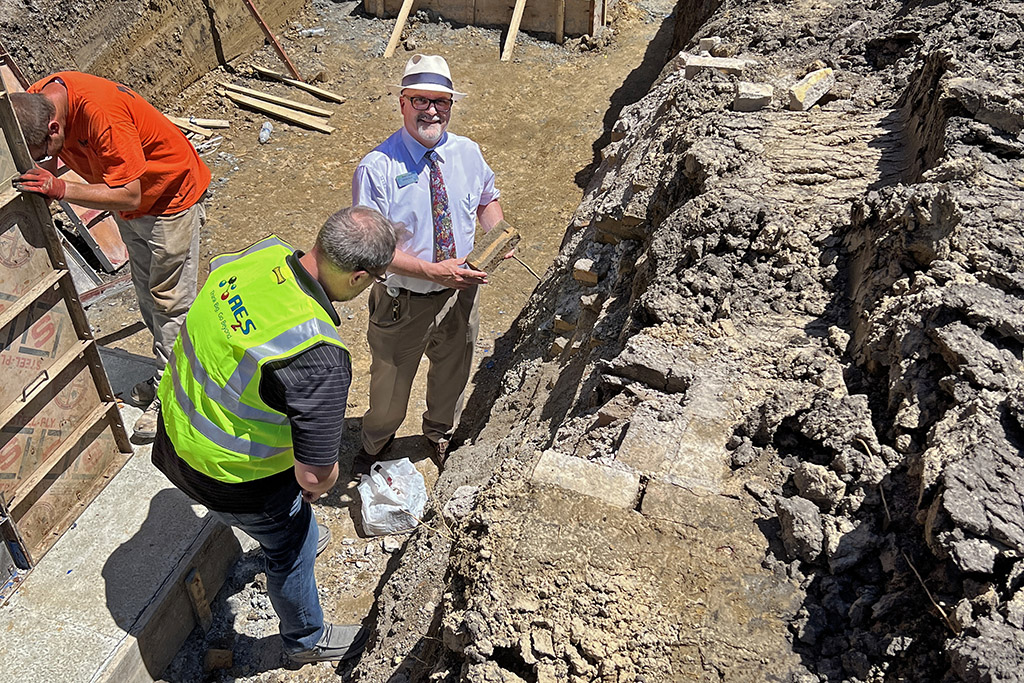
While walking around the UND campus, whether it’s one person out for leisurely stroll or a group of students scurrying between classes, few probably realize they’re treading just above the vestiges of a University that no longer exists.
In the past five years when UND began tearing down older buildings, constructing new ones and renovating others, as well as improving underground infrastructure, remnants and artifacts from the university during the late 1800s and early 1900s have been unearthed.
“Things come up as we start to dig underground on these older areas of campus,” said Brian Larson, UND’s director of construction management. “The last few years, we’ve been working on areas of campus that have been undisturbed for decades. It’s a really cool opportunity to look back in time.”
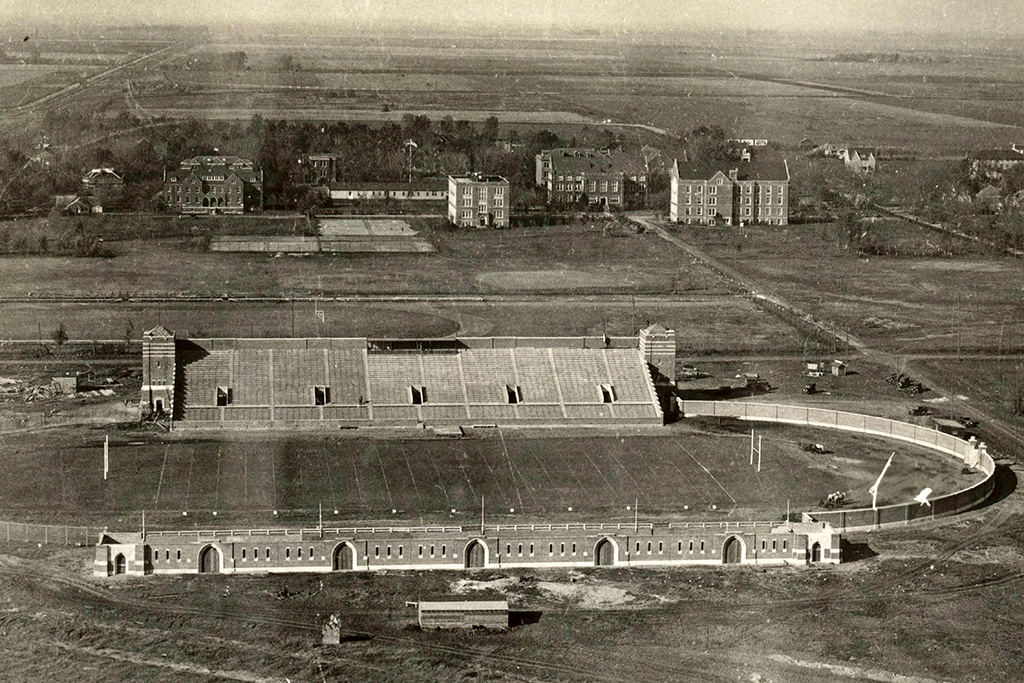
The discoveries range from the foundations and basements of buildings dating back to just after UND’s founding in 1883 to artifacts that include a section rail track for coal transport, bricks fused together, shards of pottery dredged up from the English Coulee and a buried outdoor kiln.
Working with Larson to preserve and document these finds are Darin Buri, facility and geology library manager at the College of Engineering & Mines, and Mike Bibow, assistant operations manager with AE2S engineering and environmental services in Grand Forks.
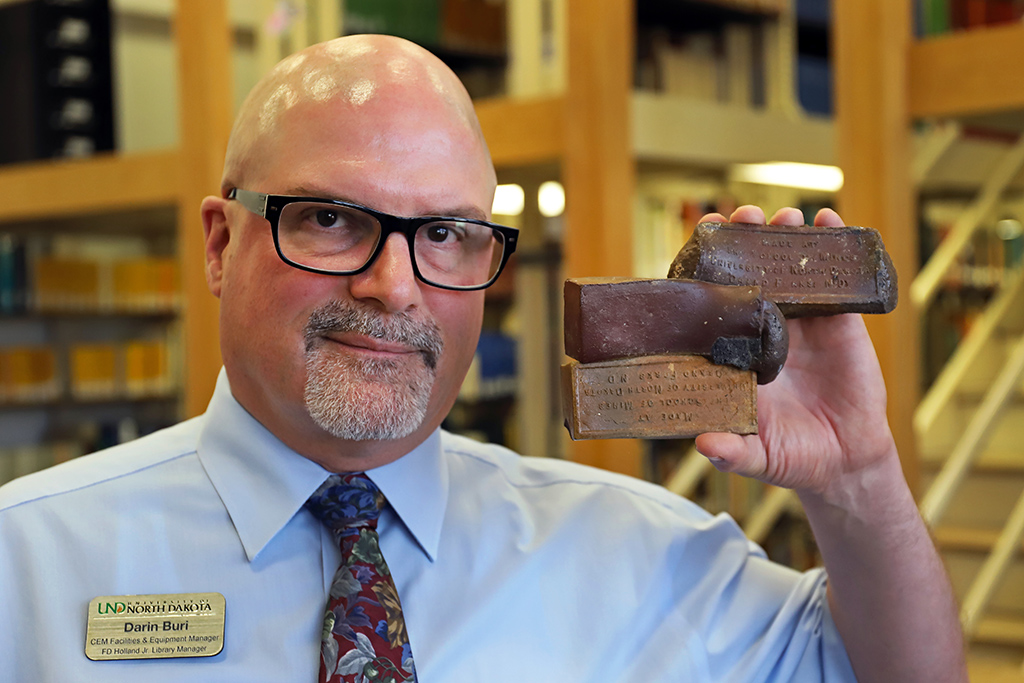
Preserving the past
Buri has made it his mission to collect remnants and examples of activities from the long-gone buildings, storing the artifacts in the geology library in Leonard Hall. Some of his discoveries serve to confirm what’s known – but perhaps forgotten – and others remain shrouded in mystery.
“It has given us a real window into the past,” Buri noted. “Even though we’re renewing the campus, we’re able to actually stand on the old floors of old buildings. It’s really cool to be able to do that.”
For example, during the summer while excavating on the south side of Chester Fritz Library, construction workers encountered the buried foundation of Woodworth Hall, a large three-story building constructed in 1910 that burned down in 1949. Buri and Bibow went into the trenches to collect samples of bricks from the foundation.
Recounting the Woodworth Hall fire, Buri said, “Somebody reported the fire during the night. It must have burned slowly because there were reports of students forming lines and throwing band uniforms and other things out the windows. it’s kind of crazy to think that students were running into a burning building.”
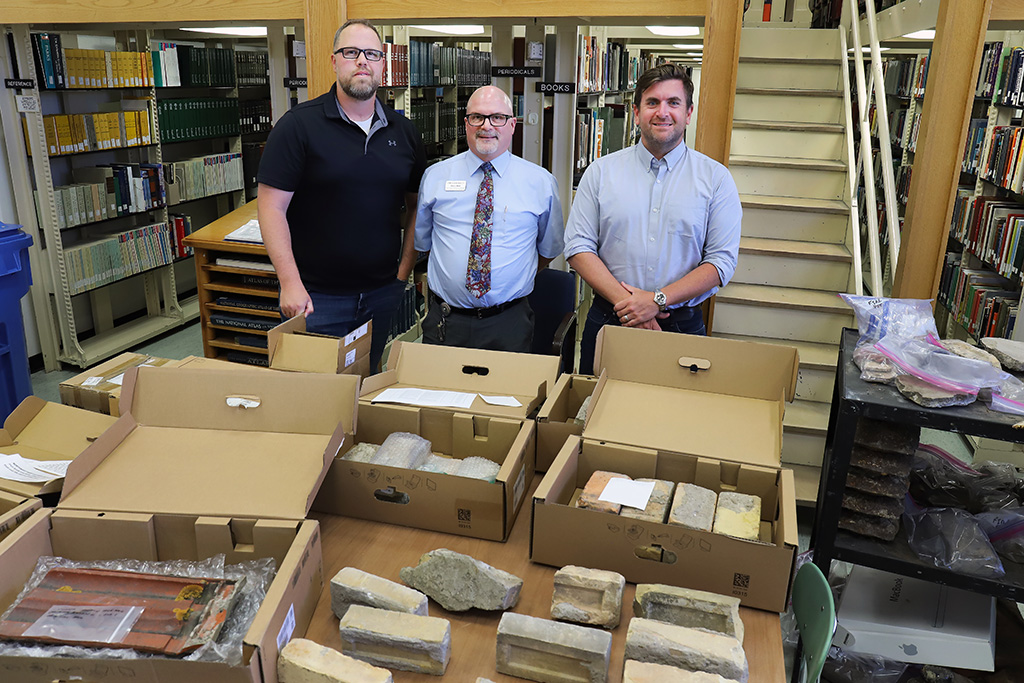
What is it?
As Bibow explained, in the past when buildings were demolished, the practice was to remove the walls to a few feet below ground level, then fill in and cover the basement and foundation walls. This is why portions of UND’s original buildings are still standing just below the surface, along with forgotten relics of the past.
“Any time we uncover something, we bring in a surveyor to put it into a map,” Bibow explained. “Sometimes you record three or four things you’ve uncovered, not knowing what they are. It’s not until you overlay it with a historical map of the campus that you realize it’s a foundation or something.”
Larson said UND has digital versions of historic campus maps from as far back as 1899.
“We have a good sense of where the outline of these original buildings are,” he said. “When you overlay maps of the old foundations on top of our new maps, you can see the progression of the campus.”
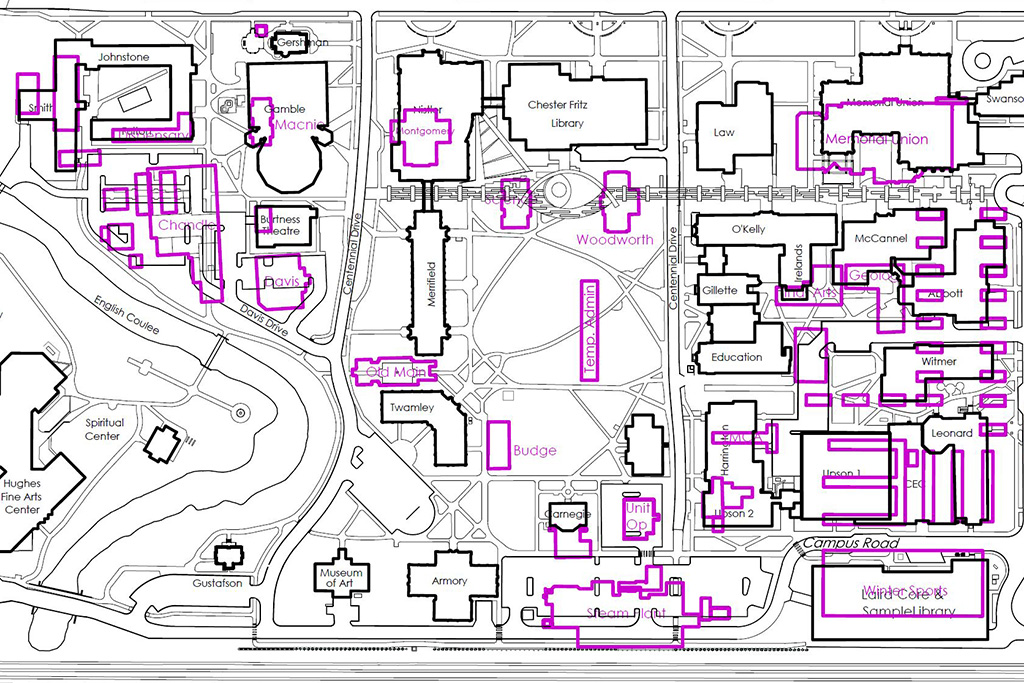
During excavations, Larson said construction crews have also encountered abandoned brick-lined steam tunnels that once provided heat to buildings on campus.
“We’ll end up trenching right through them, sealing them off and then running our new pipes through,” he said. “We still have some old brick-lined manholes on campus. A number of them are still in really good shape.”
Finding Davis
One of the biggest finds came in 2019 when a parking lot was being built south of Burtness Theatre and west of Twamley Hall, partially exposing the foundation of Davis Hall, built in 1887 and demolished in 1965.
“We didn’t know exactly what part of the building it was because we didn’t have the blueprints, but we definitely knew it was Davis Hall,” Buri recalled.
Once the blueprints were provided, the real work began.
“We realized it wasn’t just one piece of the foundation; it was pretty much the entire basement walls that were intact and part of the floor,” he said.
As the digging went deeper, it became obvious the basement had been filled with rubble from the building.
“In those rubble piles, there was a lot of contents from the era mixed in there,” Buri said. “There were milk bottles, cutlery, garbage and all sorts of miscellaneous contents uncovered.”
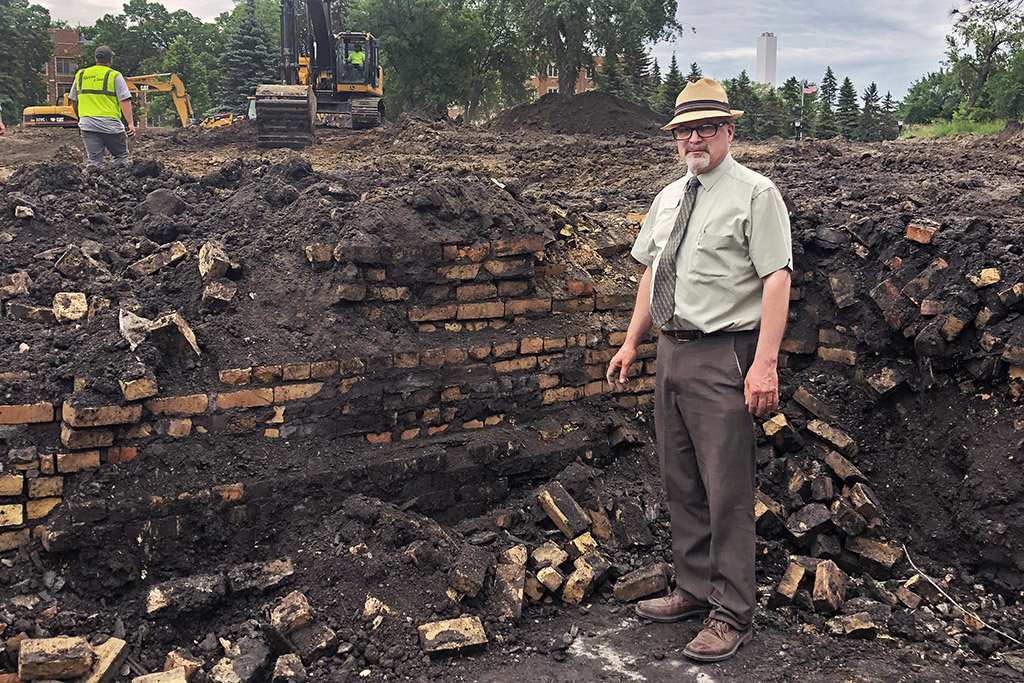
Farther to the northwest, the foundations of smaller buildings were found, along with a kiln.
“The kiln was way below the surface,” Buri said. “It still had cast-iron grates intact. We found inkwells and many different things down there. We were able to dig that out and get some pictures before they hauled it away.”
The kiln’s purpose remains one the unsolved mysteries of UND’s underground past. Another mystery is: how did so much broken pottery end up in the coulee near the bridge south of the Hughes Fine Arts Center?
Bibow described how the foundation of Budge Hall – one of the original buildings on the UND quad located directly east of Twamley Hall – was accidentally found.
“We were trying to install lights and would drill down about three feet deep before hitting concrete,” he said. “You’d move over and drill, hit something else and move over again. Based on the locations we tried to drill, we started seeing this pattern. We found some old maps and, sure enough, it was Budge Hall.”
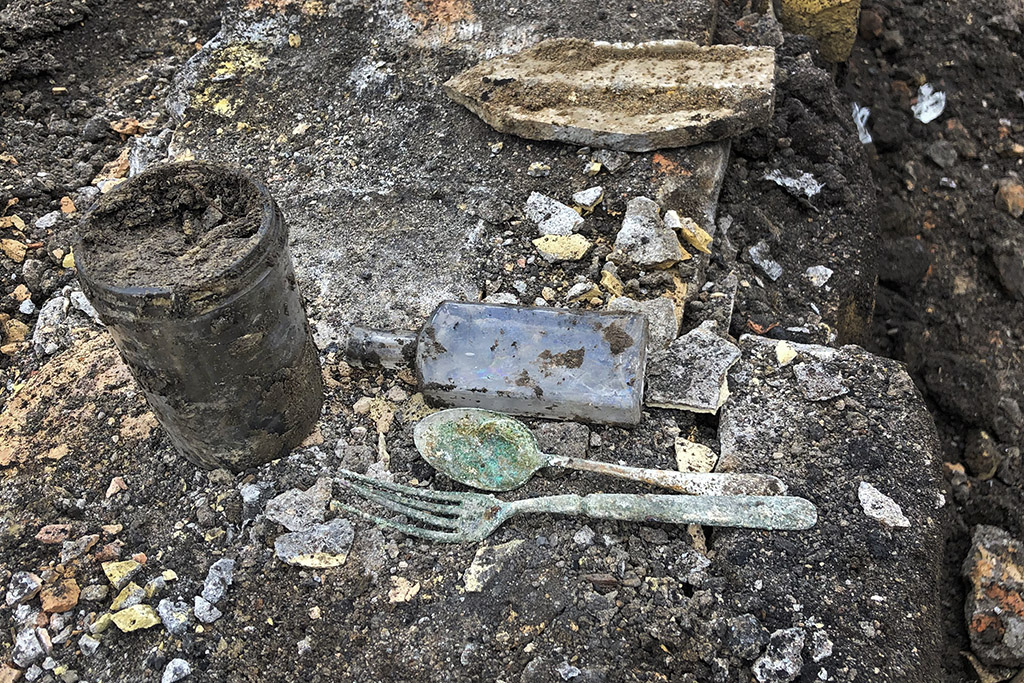
Still seeking answers
Buri is hopeful that UND alumni who have old photos or postcards of campus or memories of activities in and uses of the university’s early buildings will be willing to share them to help fill in the blanks.
“Maybe people could send us their scans of photos so we can see some of these old buildings,” he said. “I’m sure there are people out there who lived in Davis Hall when it was a women’s dormitory.”
Larson believes that when renovations on Merrifield and Twamley halls begin soon, it’s likely the foundation of UND’s first building – Old Main, which was torn down in 1963 – will be uncovered. That site lies under the Eternal Flame sculpture between the two buildings.
“The upcoming renovation at Merrifield will involve some underground work, probably some foundation waterproofing,” he said. “We’ll be excavating around Merrifield, an area that hasn’t been disturbed since the hall was finished in 1929.”
These underground finds are not only valuable for preserving the history of UND’s campus, but also in providing architectural continuity as new buildings are constructed and older buildings are renovated.
“Referencing back to the original buildings on campus is always important,” Larson said. “The campus has to have a sense of history to it.”
To download the latest map from UND Facilities Management showing the locations of existing buildings on campus and buildings that have been demolished, please click here.



